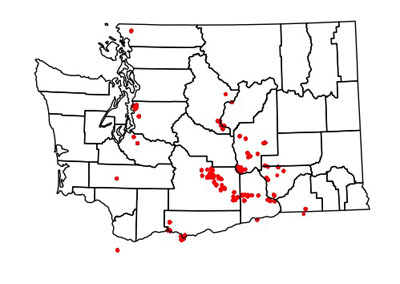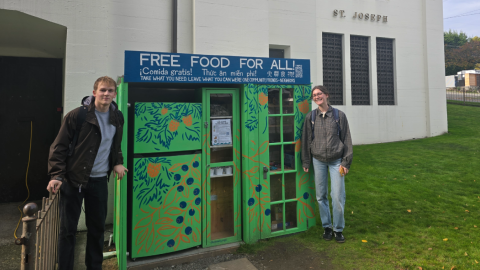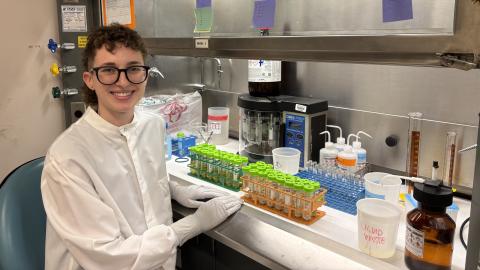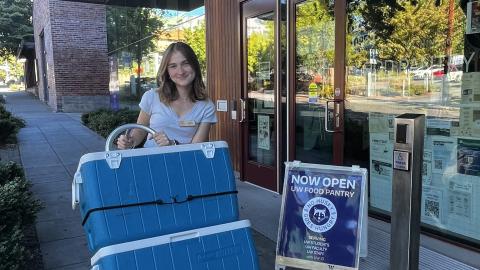Aarti Tandon
BA, Food Systems, Nutrition and Health
Hometown
Yorba Linda, CA
Future plans
To pursue medicine in environmental and occupational health.
“I believe my research helps reduce gaps in fair and equal access for marginalized peoples.”
- Aarti Tandon
Husky 100 winner and recent UW School of Public Health graduate Aarti Tandon is a student research assistant for the Pacific Northwest Agricultural Safety and Health (PNASH) Center, part of the UW Department of Environmental & Occupational Health Sciences (DEOHS). She was also recently awarded a Population Health Library Research Award from the UW Population Health Initiative.
Sarah Fish, communications co-lead for PNASH, recently spoke with Tandon about her user experience research for the center’s bilingual Pesticide Labels, Now! app and what comes next for the project.
What brought you to the field of agricultural health and safety?
I'm an aspiring physician in environmental and occupational medicine. So, I'm motivated to further agricultural health and safety in response to the prevalent systemic issues rooted in the industry.
The harsh reality is that agricultural worker and community exposure from pesticides has led to severe illness, as well as harm toward crops and the environment.
In Washington state, the majority (83%) of agricultural workers self-identify as Hispanic with 77% of these laborers reporting they are most comfortable understanding Spanish. But pesticide information regarding health and safety is solely provided in English by manufacturers.
Pesticide handlers, managers and supervisors are unable to understand this information and change behaviors accordingly. It puts them at risk for the harmful effects of agricultural pesticides.
Upon receiving the opportunity to research bilingual health and safety messaging through the SURE-EH program, I was able to stand in the middle line of transference where technology meets human health.
What are the aims of your current research?

Several years ago, DEOHS launched the Pesticide Labels, Now! application. UW researchers developed this first-of-its-kind mobile app to provide pesticide labels and their safety information in both English and Spanish.
My current research investigates whether this app has been successful in targeting the Washington farmworker population in gaining access to this safety information.
As a novice to the coding world, I had the responsibility of learning R-Studio programming with minimal experience. I definitely had a lot of debugging issues at first; however, my mentor, DEOHS Clinical Assistant Professor Eddie Kasner, really helped me grasp an understanding of how to code.
Can you tell me about a typical day in your position?
While I have worked in research before, I can definitely say that I have never studied environmental and occupational health like this before. The research has given me hands-on experience in combating pesticide exposure and protecting agricultural workers.
A typical day in my position starts with entering pesticide labels’ safety information into the database for it to be translated, checked and entered into the app. This work is time consuming, but the reward is that the app is able to provide a varied and updated list of pesticides on a weekly basis.
Upon completing my label quota for the day, I create graphs and tables on R-Studio that analyze the application’s audience. The data is pushed up to GitHub for [my mentor] Eddie to look over and suggest feedback.
What do you hope the impact of your research will be?
By understanding how users interact with the application, we are able to create a more user-friendly experience. This in turn helps to improve access to safety information on pesticide labels.
I believe my research helps reduce gaps in fair and equal access for marginalized peoples. Using statistics and data visualization, I can contribute to research translation and the improvement of human health, environmental resilience, and social and economic equity.
Additionally, we know that climate change is expected to expand agricultural pest pressure and drive increased pesticide use in the coming decades. Adoption of tools like this app will continue to foster healthier communities and healthier people through climate resilience and adaptation.
This piece is adapted from the full interview here.
The Pesticide Labels Now team consists of researchers, students and staff, including Kit Galvin, Pablo Palmández, Idanis Cruz, Elizabeth Rott and others.




